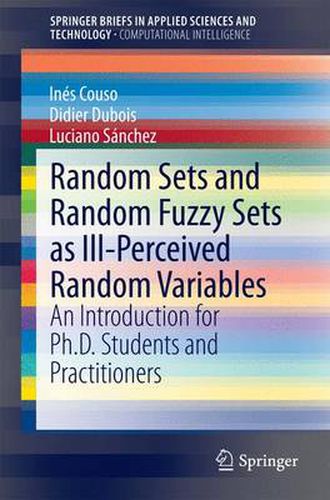Readings Newsletter
Become a Readings Member to make your shopping experience even easier.
Sign in or sign up for free!
You’re not far away from qualifying for FREE standard shipping within Australia
You’ve qualified for FREE standard shipping within Australia
The cart is loading…






This title is printed to order. This book may have been self-published. If so, we cannot guarantee the quality of the content. In the main most books will have gone through the editing process however some may not. We therefore suggest that you be aware of this before ordering this book. If in doubt check either the author or publisher’s details as we are unable to accept any returns unless they are faulty. Please contact us if you have any questions.
This short book provides a unified view of the history and theory of random sets and fuzzy random variables, with special emphasis on its use for representing higher-order non-statistical uncertainty about statistical experiments. The authors lay bare the existence of two streams of works using the same mathematical ground, but differing form their use of sets, according to whether they represent objects of interest naturally taking the form of sets, or imprecise knowledge about such objects.
Random (fuzzy) sets can be used in many fields ranging from mathematical morphology, economics, artificial intelligence, information processing and statistics per se, especially in areas where the outcomes of random experiments cannot be observed with full precision. This book also emphasizes the link between random sets and fuzzy sets with some techniques related to the theory of imprecise probabilities.
This small book is intended for graduate and doctoral students in mathematics or engineering, but also provides an introduction for other researchers interested in this area. It is written from a theoretical perspective. However, rather than offering a comprehensive formal view of random (fuzzy) sets in this context, it aims to provide a discussion of the meaning of the proposed formal constructions based on many concrete examples and exercises. This book should enable the reader to understand the usefulness of representing and reasoning with incomplete information in statistical tasks. Each chapter ends with a list of exercises.
$9.00 standard shipping within Australia
FREE standard shipping within Australia for orders over $100.00
Express & International shipping calculated at checkout
This title is printed to order. This book may have been self-published. If so, we cannot guarantee the quality of the content. In the main most books will have gone through the editing process however some may not. We therefore suggest that you be aware of this before ordering this book. If in doubt check either the author or publisher’s details as we are unable to accept any returns unless they are faulty. Please contact us if you have any questions.
This short book provides a unified view of the history and theory of random sets and fuzzy random variables, with special emphasis on its use for representing higher-order non-statistical uncertainty about statistical experiments. The authors lay bare the existence of two streams of works using the same mathematical ground, but differing form their use of sets, according to whether they represent objects of interest naturally taking the form of sets, or imprecise knowledge about such objects.
Random (fuzzy) sets can be used in many fields ranging from mathematical morphology, economics, artificial intelligence, information processing and statistics per se, especially in areas where the outcomes of random experiments cannot be observed with full precision. This book also emphasizes the link between random sets and fuzzy sets with some techniques related to the theory of imprecise probabilities.
This small book is intended for graduate and doctoral students in mathematics or engineering, but also provides an introduction for other researchers interested in this area. It is written from a theoretical perspective. However, rather than offering a comprehensive formal view of random (fuzzy) sets in this context, it aims to provide a discussion of the meaning of the proposed formal constructions based on many concrete examples and exercises. This book should enable the reader to understand the usefulness of representing and reasoning with incomplete information in statistical tasks. Each chapter ends with a list of exercises.